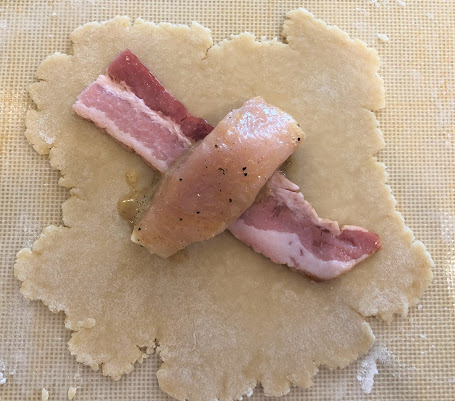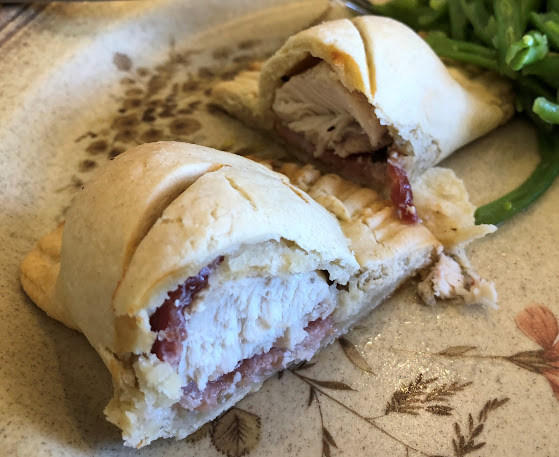My neighbors, G & T, gave me a large bag of tomatoes -- an "excess" from their family garden. I was thrilled! I had been contemplating Pinedo recipes and had not yet made up my mind which to make. This clenched it.
If you are not familiar with my series of Pinedo recipes, please click on the word "Pinedo" in the Labels section of this blog or do a search on the word "Pinedo".
I reviewed the recipes that used tomatoes and decided on the one on pages 161 and 162, Tomato Jam, which would use up most of the tomatoes they shared with me.
Miss Pinedo's recipe
My TranslationTomato jam.
Take one
ounce of sugar for each large tomato; cook to the caramel point in the pan. Add
the tenth part [of the weight of the tomatoes] of onions cut into small pieces,
and when it has begun to color, the tomatoes are put inside with salt, pepper,
cloves, and nutmeg.
Everything will be boiled over a very high heat and when it
is quite thick, it is passed through a sieve.
It is then
returned to the fire until this jam is solid. It will be emptied into jars that
will be covered with double paper to preserve it.
It can also
be composed without the onion in which case it will be used for many sauces.
You can also
make pure tomato jam, which will be used for different stews.
6 pounds fresh, ripe tomatoes
12 ounces onion (1 medium onion)
1/2 teaspoon salt
1 teaspoon pepper
1/4 teaspoon cloves
1/2 teaspoon nutmeg
1 pound sugar
The order of steps is important here because once the sugar is caramelized, it needs to be used immediately.
Core the tomatoes and chop them. Peel the onion and chop it. Sprinkle the salt, pepper, cloves, and nutmeg on top of the mixture, then stir it. Set it aside.
Use a large, heavy-bottomed kettle or Dutch oven to make the jam. First heat it over medium-high heat.
Start caramelizing the sugar by pouring in several ounces across the bottom of the kettle. Stir slowly and calmly with a wooden spoon -- avoid splashing sugar on the sides of the pan. When all the sugar has melted, pour in a few more ounces. Continue stirring. Repeat the process until all the sugar is in the pan.
When the last bit of sugar is melted, turn the heat to low. Stop stirring. Watch the sugar and, if possible, use a candy thermometer to check the temperature. The molten sugar should be a beautiful golden brown, or reach 320 to 360 degrees Fahrenheit.
Once it is ready, pour in the tomato and onion mixture. Stir well and turn the heat back up.
Keep stirring and bring the mixture to a hard boil. Continue boiling to reduce the mixture and get it thick. Stir occasionally to check that nothing is sticking to the bottom of the kettle. Reduce the heat as needed to keep the thickening mixture from splattering outside the kettle. This could take an hour or more.
Once the mixture is thick, puree it with a stick blender or in batches in a regular blender. It won't be smooth but will look a lot like commercially-made tomato sauce.
Return the mixture to a simmer over low heat until it gets very thick, like a jam. Stir often to stop it from sticking.
Put into jars and refrigerate.
My Notes
I used a food processor to get everything chopped into small pieces. I worked in small batches and combined the batches together in one big bowl. Note that I did not put the onions into the caramelized sugar to brown before the tomatoes went in.
 |
| Everything together, before the spices were stirred in. |
One pound of melted sugar did not get deep enough for my candy thermometer to reach it, so I went by color and used a meat thermometer to get a feel for its temperature. (I held it by hand and had a hard time keeping it off the hot bottom of the pan.)
 |
| A beautiful caramel color. |
When I poured in the tomato mixture, there was a lot of sizzling and splattering. The caramelized sugar immediately cooled to hard chunks. But with the cooking process that followed, the chunks dissolved. I suspect it might have been better to caramelize the sugar in a smaller pan and then pour that into the heated tomato mixture.
 |
| Newly combined |
As the mixture boils, it is losing water. If you don't lower the temperature while it is boiling, the tomato mixture will splatter all over your kitchen. (Trust me on this!) Check for that every time you stir it. You will feel the mixture thickening.
 |
| Reduced to thick and ready for pureeing. |
 |
| Pureed. |
Miss Pinedo says to cook the pureed mixture until it is solid. I didn't let it get that far, but it was very thick and it got thicker when it was cold. Overall, it reduced to about one-fourth of its original volume.
The Verdict
It was thick, it was red, and bits of pepper were visible in the mixture.
We tried it by itself, just off the spoon. It was sweet, but not like a fruit jam. It was savory from the spices. It was rich and had a good mouthfeel. There was a slight acid bite and a little bitter aftertaste that was not unpleasant. The main effect was a complex flavor that hinted of tomatoes but went much further than that.
We tried it spread on a flour tortilla - delicious! My neighbors used it as a sauce on shrimp and found it to be good. I think it would be a good spread on a sandwich, in the place of mayonnaise or mustard. I would put a spoonful of it on my plate to be eaten along with roast chicken or beef. It is robust enough to enhance beef and not be overwhelmed by it.
 |
| Look closely. See how thick it is and notice the pepper in it. |
Success!
I got about 6 cups of tomato jam from the 6 pounds of tomatoes. I didn't can it, so I kept it in the refrigerator. There was plenty to share with others.
As Miss Pinedo noted, you can make this without onions and even without spices. I would prefer the complex flavors because without them, I think I would just have tomato sauce or tomato paste.





















